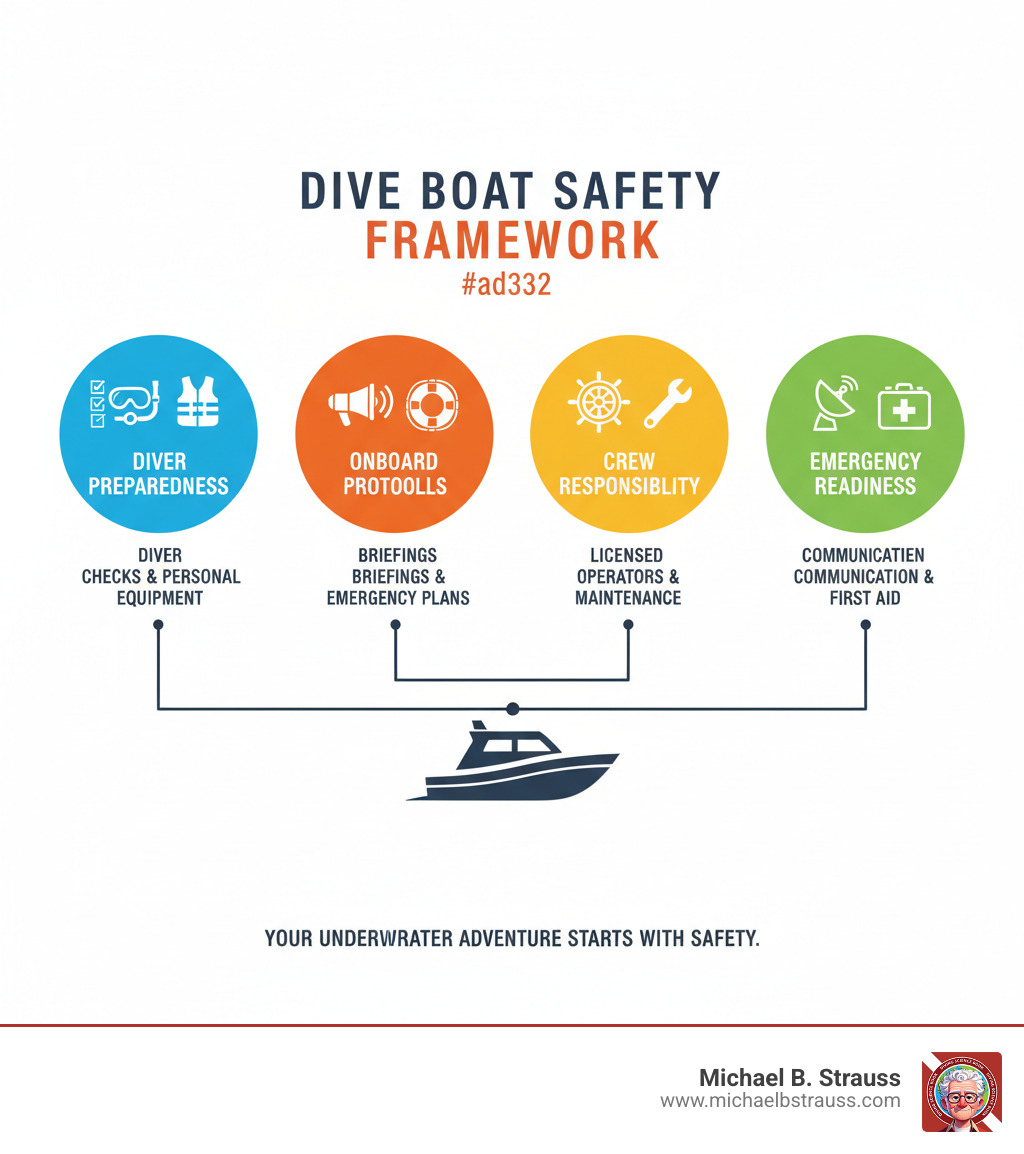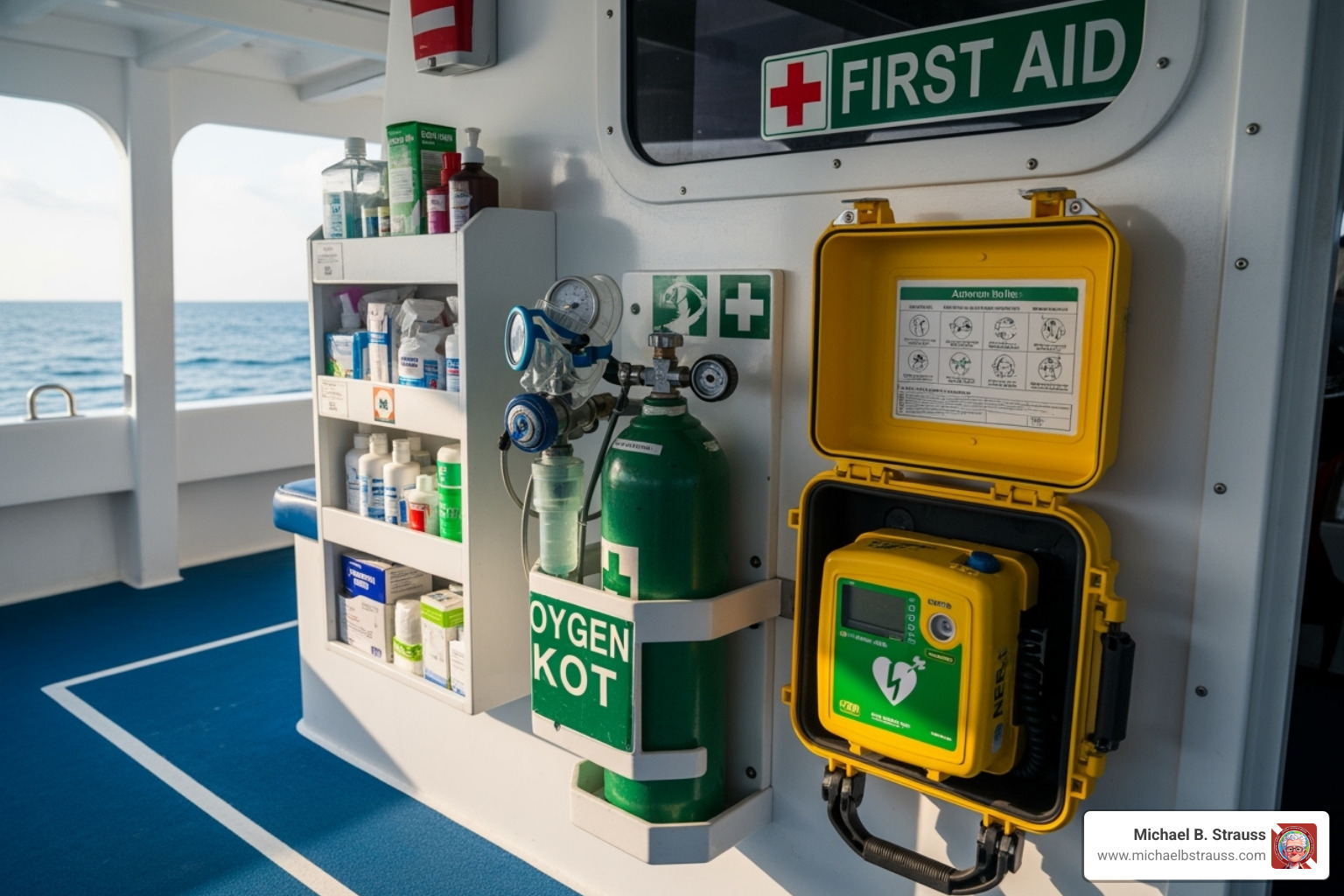Why Dive Boat Safety Matters for Every Underwater Adventure
Dive boat safety is the foundation for millions of divers worldwide to explore underwater worlds and return home safely. With up to 6 million active divers globally, the stakes are high every time we step aboard a vessel.
Essential Dive Boat Safety Principles:
- Pre-boarding assessment - Evaluate the vessel, crew, and safety equipment.
- Active participation - Listen to safety briefings and understand emergency procedures.
- Personal preparedness - Bring your own safety gear and maintain situational awareness.
- Clear communication - Establish signals with the crew before entering the water.
- Emergency readiness - Know the location of oxygen kits, first aid, and communication devices.
Boats are essential gateways to most diving adventures. But things can go wrong, as one diver recounted: "As we ascended the mooring line, it became obvious that our boat was no longer attached. We were panic-stricken!"
This scenario highlights why dive boat safety is a shared responsibility between operators, crew, and divers. The U.S. Coast Guard reports steady casualties related to recreational diving vessels, making proper safety protocols more critical than ever. Understanding regulations, recognizing danger zones, and preparing for emergencies can mean the difference between a memorable dive and a preventable tragedy.

A Diver's Guide to Comprehensive Dive Boat Safety
Every successful dive begins with a shared commitment to safety that starts when you research dive operators and continues until you're back on land.
Before You Board: Vetting the Vessel and Preparing Your Gear

Choosing the Right Dive Operator
Your dive boat safety journey starts with research. A reputable operator will be transparent about their credentials, safety record, and boat maintenance. When you arrive at the dock, trust your instincts. If something feels off, it probably is.
Red Flags That Should Send You Home
- Disorganized or unprofessional crew: A good crew is confident, knowledgeable, and eager to discuss safety. If they seem nervous or can't answer basic questions, be wary.
- Poor boat maintenance: Look for frayed ropes, general neglect, or a dirty, disorganized boat. These often signal deeper mechanical issues.
- Unhealthy engine sounds: An engine that coughs, wheezes, or produces excessive smoke is a warning sign.
- Reluctance to discuss safety: Professional crews welcome safety questions. If they seem annoyed or rush past the topic, it's a major red flag.
Overcoming Pressure to Dive Unsafe
You may feel pressure to dive after investing time and money, but no dive is worth your life. Remember: it's always better to be alive than to save money on a dive.
Your Personal Safety Arsenal
Beyond standard gear, carry your own safety equipment:
- Surface Marker Buoy (SMB) or Delayed SMB: Makes you visible to the boat crew.
- Whistle: An effective way to get attention on the surface.
- Line Cutter: Essential for mess emergencies.
- Compact Personal First Aid Kit: Ensures you have immediate access to supplies.
Private vs. Commercial Boat Diving
Diving from a private boat places more responsibility on you and your friends for navigation, safety, and emergencies. The cardinal rule is to always leave a responsible person on board who can operate the boat. Commercial charters operate under stricter regulations with trained crews, but your personal awareness remains crucial.
Mastering Onboard Protocols for Improved Dive Boat Safety
Once aboard, your focus shifts to the vessel's specific layout and procedures.
The Safety Briefing That Could Save Your Life
The U.S. Coast Guard requires safety briefings for a reason—they contain vital information. A proper briefing covers:
- The vessel's layout, safe movement areas, and off-limit zones.
- The journey's route and expected conditions.
- Location and use of lifejackets.
- Emergency procedures, including Mayday calls and man-overboard protocols.
- Dive site details, including hazards and recall signals.
Pay close attention. Knowing what to do in an emergency is critical.
Gear Management and Danger Zones
Proper gear storage prevents accidents. Secure tanks in racks and stow bags and loose items where they won't cause trips. Rest weights on the deck, not on benches.
Be aware of common danger zones:
- Wet decks: Always slippery.
- Ladders: Use caution and grab the rungs, not the rails.
- Propeller area: Never approach when the engine is running.
- Cleats, anchors, and steps: These are trip hazards, especially when geared up.
Always maintain situational awareness and pay attention during the roll call procedure to ensure everyone is accounted for.
Understanding how pressure affects our bodies is crucial for safe diving. You can explore more about mammalian diving responses at michaelbstrauss.com.
In-Water Conduct: Safe Entries, Exits, and Surface Procedures

The transition between the boat and water requires your full attention.
Getting In and Out Safely
Before entering, have your regulator in your mouth and mask on. For any entry, check that the area below is clear of other divers. Propeller safety is paramount; never enter the water until the crew confirms the engine is off.
When exiting, stay clear of the ladder while others are climbing. Remove your fins while still in the water and hand them up to the crew to avoid tripping. Grab the ladder rungs, not the rails.
Dive Flags and Their Meanings
- Diver Down flag (red with a white diagonal stripe): Used by dive boats to signal divers are in the water.
- Alpha flag (blue and white, swallow-tailed): An international signal meaning "I have a diver down; keep clear at slow speed."
These flags protect you from other boat traffic.
Surface Communication and Safety
On the surface, you can be hard to spot. Your surface marker buoy and whistle are crucial for visibility and getting attention. Each diver should use their own dive computer to track their personal dive profile.
Following your computer's limits connects directly to decompression science—a topic you can explore further at michaelbstrauss.com.
The Operator's Duty: A Foundation for Dive Boat Safety

While divers share responsibility, the captain and crew hold ultimate accountability for everyone aboard. Their training and adherence to regulations form the bedrock of dive boat safety.
Captain and Crew Responsibilities
A USCG licensed captain is a trained professional responsible for your safety. Their duties include:
- Providing clear safety briefings.
- Ensuring safe transit to and from dive sites.
- Overseeing safe water entry and exit procedures.
- Maintaining constant diver accounting through roll calls.
- Coordinating recovery and rescue operations during emergencies.
- Regular vessel maintenance and crew training.
Understanding Vessel Classifications: Six-Pack vs. Inspected Boats
Not all dive boats operate under the same regulations. "Six-pack" boats carry up to six passengers and are not regularly inspected by the Coast Guard, placing more importance on your own evaluation. Inspected vessels carry more passengers and undergo annual safety inspections.
| Feature | 'Six-Pack' Uninspected Vessels (UPV) | Inspected Vessels (COI) |
|---|---|---|
| Passenger Limits | 6 passengers for hire (under 100 gross tons), or 12 passengers if over 100 gross tons | Passenger limits specified on Certificate of Inspection, often much higher |
| Inspections | Not regularly inspected by Coast Guard | Annual safety inspections and hull inspections every 2 years |
| Captain Requirements | Operator of Uninspected Passenger Vessels (OUPV) license | Higher-grade Master's license specific to vessel tonnage and route |
| Safety Equipment | Basic carriage requirements for safety gear | More comprehensive safety equipment requirements |
| Documentation | Specific requirements for radio and lifesaving equipment | Certificate of Inspection detailing all safety requirements and limitations |
You can learn more from the U.S. Coast Guard requirements for uninspected vessels.
Essential Safety Equipment: Your Lifeline in Emergencies
A professional dive boat should be equipped with:
- Assisting equipment: A tagline (a floating rope at the stern), throw bags, and boat hooks.
- Communication equipment: VHF radios (with Channel 16 for emergencies), cell/satellite phones, visual distress signals (flares), and an EPIRB.
- Medical equipment: A comprehensive first aid kit, medical oxygen (critical for diving injuries), and often an Automated External Defibrillator (AED).
Emergency Procedures: When Things Go Wrong
Professional operators have detailed plans for emergencies like man overboard incidents, lost diver searches, fires, and vessel abandonment. This commitment to safety demonstrates a culture where dive boat safety is a fundamental value.
Conclusion: Making Every Dive a Safe Return
Dive boat safety is a shared responsibility between divers, crew, and captains. When everyone is prepared and vigilant, every dive can be a safe and memorable adventure.
Our safety journey begins before we board, by vetting operators and trusting our instincts. As one experienced diver advises, "it's always better to be alive than to save money on a dive." Personal preparedness is also key; carrying an SMB, whistle, and line cutter gives you control over your safety.
Onboard, actively listening to safety briefings is not routine—it's a lifeline. Understanding emergency procedures, recall signals, and danger zones makes you a partner in safety. In the water, following proper entry, exit, and surface protocols ensures a smooth transition from the boat and back.
Finally, professional operators and their crews provide the foundation of safety. Their adherence to regulations, maintenance of essential equipment like medical oxygen and AEDs, and established emergency plans are critical.
Dr. Michael B. Strauss reminds us that knowledge is our most powerful safety tool. Understanding the science behind diving empowers us to make better decisions. Proper preparation and working with competent operators give us the freedom to fully enjoy the underwater world, knowing we've prioritized safety first.
To learn more, get your copy of "Diving Science Revisited" by clicking here.
DISCLAIMER: Articles are for "EDUCATIONAL PURPOSES ONLY", not to be considered advice or recommendations.






